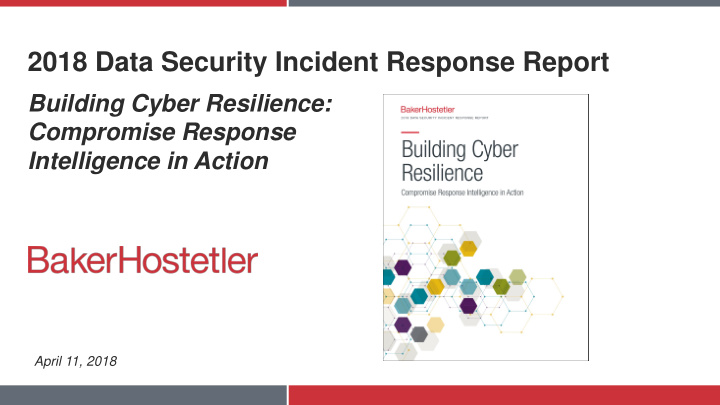



2018 Data Security Incident Response Report Building Cyber Resilience: Compromise Response Intelligence in Action April 11, 2018
Contact Information Theodore J. Kobus, III Casie D. Collignon Leader, Privacy and Data Protection Practice Partner New York Denver 212.271.1504 303.764.4037 tkobus@bakerlaw.com ccollignon@bakerlaw.com Lynn Sessions Craig A. Hoffman Partner Partner Houston Cincinnati 713.646.1352 513.929.3491 lsessions@bakerlaw.com cahoffman@bakerlaw.com
About the Team • 50+ member team • 15+ members for Incident Response • Chambers Ranked • Law360 Privacy Team of the Year (2013 - 2015) • Law360 Privacy MVPs (2013 - 2016) • Law360 Privacy “Rising Stars” (2013 - 2016) • 2500+ incidents
The 2018 Report • 560+ Incidents • All industries represented • Phishing and exploitation of vulnerable systems top the list of why incidents occur • Regulators are getting more involved • Companies of all sizes impacted • Crypto-miner attacks on the rise • Ransomware is not going away • Forensics drive key decisions • Privilege issues need to be considered early
Compromise Ready • Contractual obligations & regulatory compliance • Threat information gathering • Technology – preventative & detective • Personnel – awareness & training • Security Assessments – Identify assets and sensitive data – Implement reasonable safeguards – Increase detection capabilities • Vendor management • Conduct tabletop exercises • Cyber liability insurance • Ongoing diligence and oversight (leverage cyber response intelligence to prioritize) 6
Compromise Response Intelligence • Run of the mill to the best attackers get in through phishing • It’s not just about protecting sensitive data, operational resiliency is equal risk • Acquisitions bring new risk • Multifactor authentication is the gold standard • It’s not the cloud, it’s you (or your vendor) • Rise of the regulator • New year, same old issues • Everyone’s involved • GDPR countdown drives uncertainty • Litigation uncertainty 7
Incident Response Trends The overarching takeaway is that companies need to continue focusing on the basics to become and remain “Cyber Resilient” • No one is immune • Operational resiliency • The people problem • Practice • Response metrics • Choose carefully • Let forensics drive the decision making • Biggest consequences?
Industries Affected
Why Do Incidents Occur?
Ransomware is not Going Away • Critical reliance on technology • New iterations affect mobile and IoT devices • Low entry cost for cybercriminals • Business oriented ransomware models are: – Developing new strains – Engaging in customer service – Data mining
Companies of all Sizes Impacted 12
Forensic Investigations Critical Steps: • Identify a forensic firm • Conduct onboarding • Collect good log data accessible from a centralized source
Data at Risk
Notification Summary
Incident Response Timeline
Attorneys General are Active Be prepared to provide the following information: • Detailed timeline of the incident • Narrative describing the incident • How the incident was discovered • Company polices/procedures addressing information security • Safeguards and corrective actions taken Complaints received • Details of the mitigation efforts
Payment Card Data • Timing • Cost • Fines • Trends
EU Security Incident Response Rules • Describe nature of the brief • Include contact information for the organization’s Data Protection officer • Detail the consequences of the breach • List remediation and mitigation steps they have taken or will take in response.
Back to the Basics – 12 Steps to Building Cyber Resilience Compromise Response Intelligence in Action 1. Increase Awareness of Cybersecurity Issues 2. Identify and Implement Basic Security Measures 3. Create a Forensics Plan 4. Build Business Continuity Into Your Incident Response Plan (IRP) 5. Manage Your Vendors 6. Combat Ransomware 7. Purchase the Right Cyber Insurance Policy 8. Implement a Strong Top-down Risk Management Program 9. Adopt Updated Password Guidance, and Implement MFA or Other Risk-based Authentication Controls 10. Keep Data Secure in the Cloud 11. Prepare for More Regulatory Inquiries 12. Publicly Traded Entities Should Update Risk Factors Regarding Privacy and Security
Data Security Litigation Trends
Data Security Litigation: Take Action 22
Developing a Defense Strategy • Consider a variety of factors before seeking dismissal for lack of standing, including: 1. How does the jurisdiction view standing? 2. Has the plaintiff suffered identity theft or other harm? 3. What happens if the case is dismissed? • Be prepared to respond as plaintiffs continue to test new angles to advance beyond the dismissal stage, such as unjust enrichment or breach of contract
Atlanta Chicago Cincinnati Cleveland Columbus Costa Mesa Denver Houston Los Angeles New York Orlando Philadelphia Seattle Washington, DC bakerlaw.com These materials have been prepared by Baker & Hostetler LLP for informational purposes only and are not legal advice. The information is not intended to create, and receipt of it does not constitute, a lawyer-client relationship. Readers should not act upon this information without seeking professional counsel. You should consult a lawyer for individual advice regarding your own situation.
Recommend
More recommend